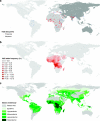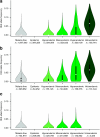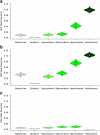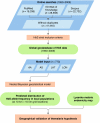Global distribution of the sickle cell gene and geographical confirmation of the malaria hypothesis
- PMID: 21045822
- PMCID: PMC3060623
- DOI: 10.1038/ncomms1104
Global distribution of the sickle cell gene and geographical confirmation of the malaria hypothesis
Abstract
It has been 100 years since the first report of sickle haemoglobin (HbS). More than 50 years ago, it was suggested that the gene responsible for this disorder could reach high frequencies because of resistance conferred against malaria by the heterozygous carrier state. This traditional example of balancing selection is known as the 'malaria hypothesis'. However, the geographical relationship between the transmission intensity of malaria and associated HbS burden has never been formally investigated on a global scale. Here, we use a comprehensive data assembly of HbS allele frequencies to generate the first evidence-based map of the worldwide distribution of the gene in a Bayesian geostatistical framework. We compare this map with the pre-intervention distribution of malaria endemicity, using a novel geostatistical area-mean comparison. We find geographical support for the malaria hypothesis globally; the relationship is relatively strong in Africa but cannot be resolved in the Americas or in Asia.
Figures





References
-
- Serjeant G. R. & Serjeant B. E. Sickle Cell Disease (Oxford University Press, 2001).
-
- Weatherall D., Akinyanju O., Fucharoen S., Olivieri N. & Musgrove P. in Disease Control Priorities in Developing Countries (eds Jamison, D. T. et al..) Ch. 34, 663–680 (Oxford University Press, 2006).
-
- Livingstone F. B. Frequencies of Hemoglobin Variants: Thalassemia, the Glucose-6-Phosphate Dehydrogenase Deficiency, G6Pd Variants and Ovalocytosis in Human Populations (Oxford University Press, 1985).

